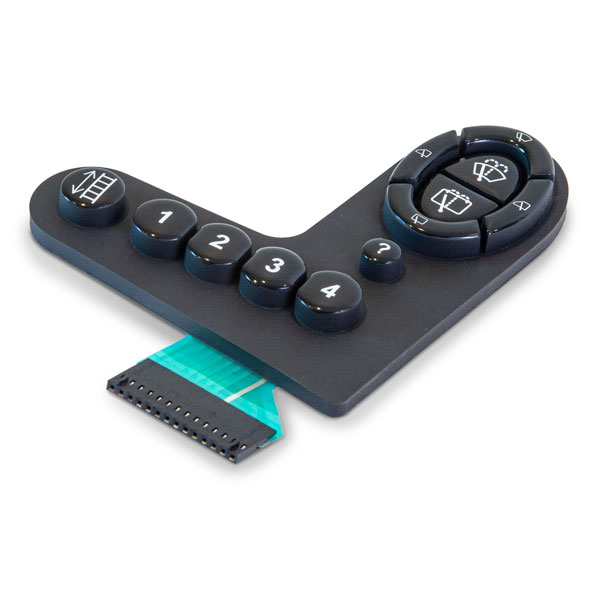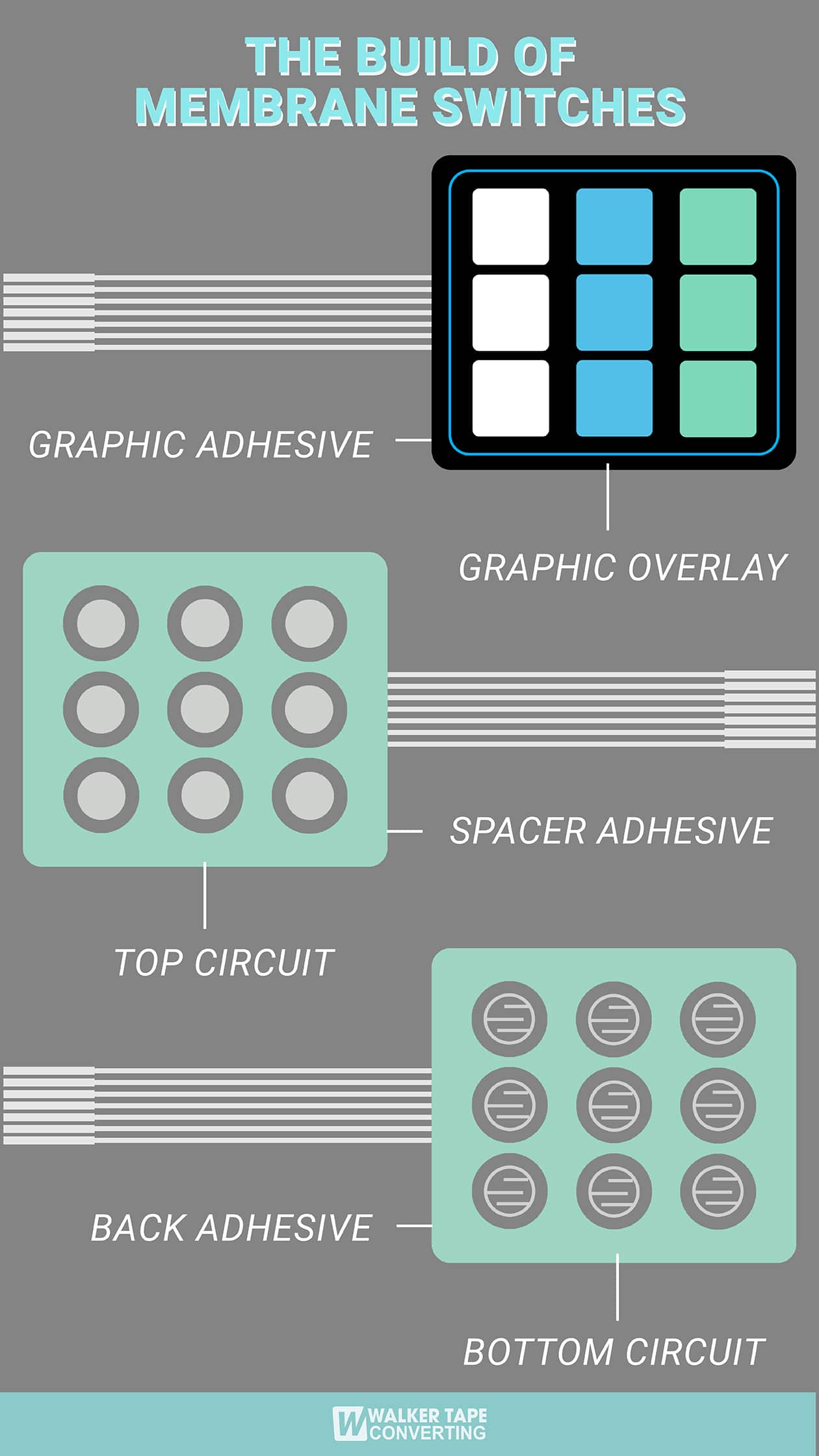Everything About Membrane layer Change: A Comprehensive Guide for Beginners
Membrane layer buttons are vital parts in contemporary electronic devices, providing an unique user interface for user interaction - membrane switch. Their split building and construction, including overlays and conductive traces, provides performance and longevity. Unlike conventional mechanical buttons, membrane switches present a smooth layout and customizable alternatives. Comprehending their crucial features and benefits can change product design. Nevertheless, the intricacies of their application and design considerations necessitate additional expedition
What Is a Membrane Change?
A membrane button is a sort of electric button that includes a versatile membrane layered over a printed motherboard. This layout enables a streamlined and portable interface, usually made use of in different digital tools. Membrane buttons are frequently found in consumer devices, medical equipment, and commercial equipment because of their longevity and resistance to ecological factors.The building and construction generally includes numerous layers, such as visuals overlays and adhesive backing, which offer tactile comments and shield the wiring below. The operation of a membrane button is started when pressure is put on the surface, completing an electrical circuit.These switches are valued for their adaptability, allowing custom-made layouts and printed graphics that accommodate details customer interfaces. Their low-profile nature decreases space demands, making them ideal for applications where typical buttons might not fit. On the whole, membrane switches provide a aesthetic and functional solution for contemporary digital devices.
Trick Components of Membrane Layer Changes
Membrane layer switches over consist of numerous essential components that add to their capability and efficiency. The top layer, known as the overlay, provides the individual interface and is usually printed with graphics or symbols. Under the overlay exists a spacer layer, which separates the conductive elements and stops unintended activation. The following crucial element is the graphic layer, which improves looks and guarantees the durability of the design.Conductive traces, normally made from products like silver or carbon, are printed on the circuit layer. When pressure is related to the overlay, these traces enter into contact, finishing the circuit. Additionally, a support layer uses architectural support and can be made from products such as polyester or polycarbonate. With each other, these elements produce a trustworthy, easy to use interface ideal for different applications, from home devices to commercial devices. Comprehending these aspects is important for any person thinking about membrane switch innovation.
How Membrane Changes Job
Understanding just how membrane switches function is essential for valuing their extensive use in different gadgets. A membrane layer switch operates through a collection of layers, consisting of a visuals overlay, spacer, and a circuit layer. When stress is related to the overlay, it compresses the spacer layer, allowing the circuit layer to make contact and complete an electrical circuit. This action sends out a signal to the device, motivating an action, such as turning on a light or activating a function.Membrane switches can be developed with numerous functions, consisting of tactile comments, backlighting, and custom graphics, improving individual communication. Their construction enables a covered style, protecting the internal elements from dirt, moisture, and impurities. This toughness makes them ideal for diverse applications, from customer electronics to industrial devices. Overall, the simplicity and efficiency of membrane switches over add to their appeal in modern-day innovation.
Benefits of Membrane Switches Mechanical Buttons
While mechanical buttons have actually long been a staple in numerous tools, membrane switches offer distinctive benefits that make them increasingly appealing. One considerable benefit is their slim profile, allowing for more compact styles and better versatility in item advancement. Additionally, membrane layer switches function a consistent surface, which improves visual allure and streamlines cleansing, making them suitable for atmospheres where health is critical.Another benefit is their resistance to dirt and dampness. Unlike mechanical buttons, which can be jeopardized by ecological factors, membrane layer switches give a covered interface that safeguards versus pollutants - membrane switch. Moreover, membrane switches generally have a longer life expectancy due to fewer relocating components, causing boosted resilience and reliability.Cost-effectiveness is also a noteworthy advantage, as membrane layer switches can be produced in bulk with lower manufacturing costs. These aspects integrate to place membrane switches as a functional option to standard mechanical alternatives in different applications
Common Applications of Membrane Layer Switches Over
Membrane buttons are commonly utilized in numerous markets, particularly in consumer electronics and industrial control panels. In consumer tools, they provide a smooth, easy to use user interface, while in industrial setups, they boost durability and performance. Comprehending these applications highlights the convenience and practicality of membrane layer linked here switches in modern-day technology.
Customer Electronics Devices
As customer electronic devices remain to progress, membrane switches have actually come to be a prominent choice for a selection of tools as a result of their versatility and smooth style. These switches are generally discovered in mobile phones, tablet computers, and remote controls, where space is article source restricted and looks matter. Their reduced account and adjustable designs enable manufacturers to create user-friendly user interfaces that improve the overall user experience. Furthermore, membrane switches are often utilized in devices such as microwaves and coffee machine, supplying user-friendly control options while withstanding moisture and dirt. The resilience and dependability of membrane switches over make them ideal for day-to-day customer items, making sure longevity and consistent performance. In general, their combination in customer electronic devices reflects a mix of functionality and modern layout.
Industrial Control Panels
The applications of membrane switches expand beyond customer electronics, locating substantial use in industrial control board. These switches are favored for their sturdiness and resistance to extreme settings, making them ideal for producing and procedure control setups. They offer a dependable interface for drivers to regulate equipment, display processes, and readjust settings. Membrane switches can be personalized to fit certain operational requirements, including functions like backlighting and responsive comments, improving customer experience. Their low-profile style enables for integration into various equipment, while their capacity to hold up against spills, dirt, and extreme temperature levels warranties durability. Overall, membrane layer buttons add to reliable and risk-free operation in industrial applications, showing their flexibility and effectiveness popular environments.
Factors To Consider for Creating Membrane Switches
When designing membrane layer buttons, selecting the best products is vital to ensure durability and performance. In addition, understanding layer configuration strategies can significantly impact the switch's performance and individual experience. These factors to consider play a vital role in developing trusted and efficient membrane button styles.
Product Selection Importance
Material choice plays a necessary role in the design and performance of membrane layer buttons. The chosen materials directly affect the switch's sturdiness, responsive response, and overall aesthetic. Key factors to consider consist of the substratum, which must supply architectural honesty while permitting flexibility, and the graphic overlay, which see it here requires to be immune to put on and environmental elements. Conductive materials should guarantee dependable electric efficiency, while adhesives must use solid bonding without endangering the switch's operation. Furthermore, compatibility with making processes and end-user environments is essential; products need to stand up to differing temperature levels, humidity levels, and chemical exposure. Ultimately, proper product option not only boosts the membrane layer switch's performance however additionally adds to its longevity and user fulfillment, making it a crucial facet of the layout procedure.

Layer Setup Methods

Often Asked Questions
How Lengthy Do Membrane Switches Typically Last?
Membrane layer buttons usually have a life expectancy of 1 to 5 million cycles, depending on usage and ecological problems. Variables such as design high quality and operating regularity significantly affect their durability and overall performance durability.

Can Membrane Switches Be Custom-made for Certain Layouts?
Membrane buttons can without a doubt be personalized to accommodate certain layouts, permitting varied shapes, colors, and capabilities. This flexibility enables makers to customize these buttons to satisfy one-of-a-kind visual and functional demands properly.
What Products Are Made Use Of in Membrane Layer Switch Over Building?
Membrane buttons are typically constructed making use of materials such as polyester, polycarbonate, and adhesive layers. These products supply flexibility, resistance, and resilience to ecological variables, making certain the buttons work properly in different applications and conditions.
Are Membrane Layer Switches Over Resistant or water-proof to Wetness?
Membrane buttons can be designed to be moisture-resistant, using specialized finishings and materials. Their water resistant abilities depend on construction top quality and certain applications, making it necessary to examine requirements for suitable efficiency in different atmospheres.
How Are Membrane Layer Changes Fixed if Damaged?
Repairing broken membrane layer changes normally includes replacing the impacted layer or circuit. Professionals may additionally apply conductive sticky or utilize specialized repair service kits, ensuring functionality is brought back without total replacement of the whole switch assembly. Unlike typical mechanical buttons, membrane switches offer a streamlined layout and customizable alternatives. A membrane button is a type of electrical switch that is composed of a versatile membrane layered over a printed circuit board. The operation of a membrane switch is launched when stress is used to the surface area, completing an electrical circuit.These buttons are valued for their versatility, allowing custom layouts and published graphics that provide to details customer interfaces. While mechanical switches have long been a staple in many devices, membrane layer changes deal unique advantages that make them progressively appealing. Membrane switches typically have a longer life expectancy due to fewer relocating components, resulting in improved longevity and reliability.Cost-effectiveness is also a remarkable advantage, as membrane layer buttons can be produced in bulk with reduced production expenses.